Italy take on Spain in the semi-finals of EURO 2020 at Wembley, with this match being a rematch of the EURO 2012 final, which Spain won convincingly by a 4-0 margin. More recently, these two sides also faced each other at EURO 2016, with the Italians prevailing 2-0 on that occasion in the round of 16. Roberto Mancini has engineered a complete turnaround in Italy’s fortunes since their dismal failure to qualify for the 2018 World Cup, and the Azzurri are arguably even better than Spain at possession football at the moment. They certainly have one of the best midfields of the tournament so far, and with the Spanish trio of Sergio Busquets, Koke and Pedri not too far behind, this is set to be a superb clash, with both teams trying to play on the front foot and dominate possession. Luis Enrique has a couple of selection dilemmas to consider which could make or break this Spain side, and in this tactical preview, we will look at both teams’ expected tactics and how we think this game could play out.
Lineups
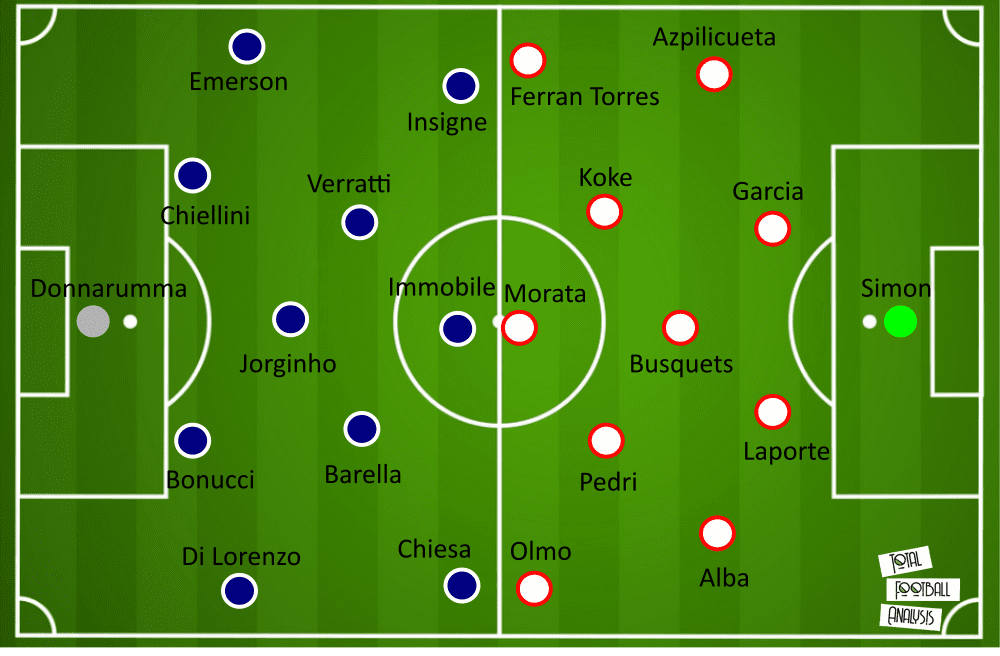
Italy will unfortunately be without Leonardo Spinazzola, who ruptured his Achilles tendon in the win over Belgium, and is expected to be out for months. Mancini will most probably bring in Emerson Palmieri of Chelsea in at left-back instead, and while the Brazilian is a decent player, he will struggle to offer the same thrust and incision that Spinazzola did. The rest of the side is expected to be the same as the one that defeated Belgium in the quarter-final.
Spain also have an injury issue of their own, as Enrique confirmed that Pablo Sarabia will miss this game with an injury picked up in the penalty shoot-out victory over Switzerland. He is likely to be replaced by Dani Olmo in the lineup, although Gerard Moreno could also come in, while in defence, we expect Enrique to restore Eric Garcia to the XI instead of Pau Torres, who once again failed to convince in his previous outing.
Both teams will try to attack down the flanks
Both Italy and Spain have seen a large part of their attack flow down their respective left flanks. For Italy, Spinazzola would bomb forward, turning the shape into a 3-2-5 when the Azzurri were in possession, allowing Lorenzo Insigne to come infield and play as a number 10 of sorts, and despite being a right-footed player playing at left-back, he was capable of going both outside and inside the opposition full-back, leaving them guessing. He was also clocked as the fastest player at EURO 2020 so far, and we can already see how difficult it will be for Italy to replace him. Spain, on the other hand, have had Jordi Alba bombing up and down their left flank, and he has combined extremely well with Pedri, who has played as the left-sided central midfielder in the Spain midfield trio. The duo have replicated their connection from Barcelona, as Pedri has drifted infield into the half-spaces while Alba stays wide and stretches the opposition. We expect this reliance on the left flank for attacking impetus to continue in this match for both teams, with some notable differences that could play a big role in deciding how this match plays out.
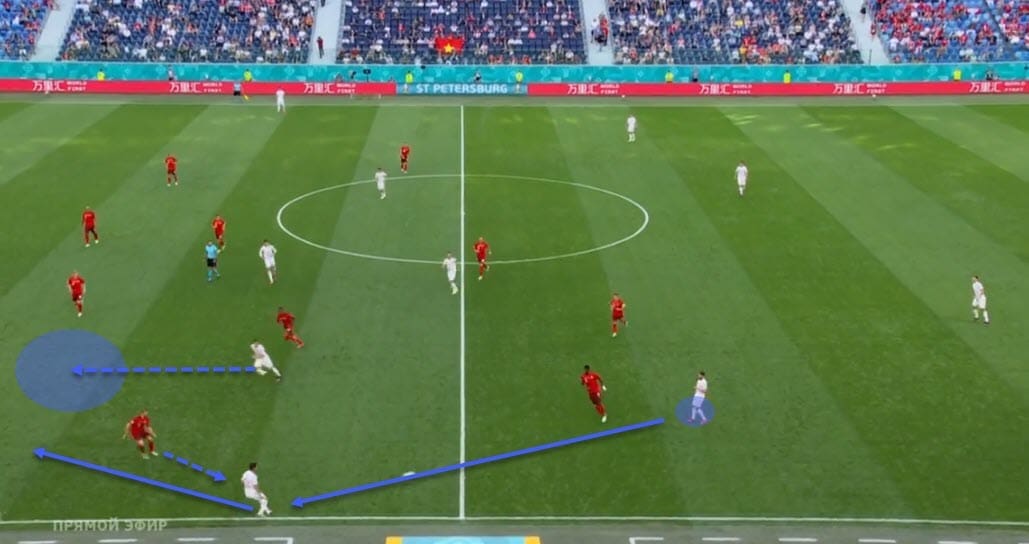
This is a perfect example of how Spain look to progress down the left flank, taken from Domagoj Kostanjsak’s post-match analysis of the Switzerland-Spain match. Both Spanish full-backs usually stay deep in their build-up to guard against turnovers of possession, but this also means that they are able to manipulate the opposition’s press and defensive lines. Here, Breel Embolo is drawn towards Alba, out of his position in the defensive line. Sarabia drops to receive possession, while Pedri makes a run into the space vacated by Stefan Widmer, the opposition right-back. Thus, Spain are usually able to progress down their left through these sort of rotations, which Italy will need to watch out for as well.
It must be noted that this is not just down their left – Spain have also been good at progressing down their right flank through similar positional interchanges.
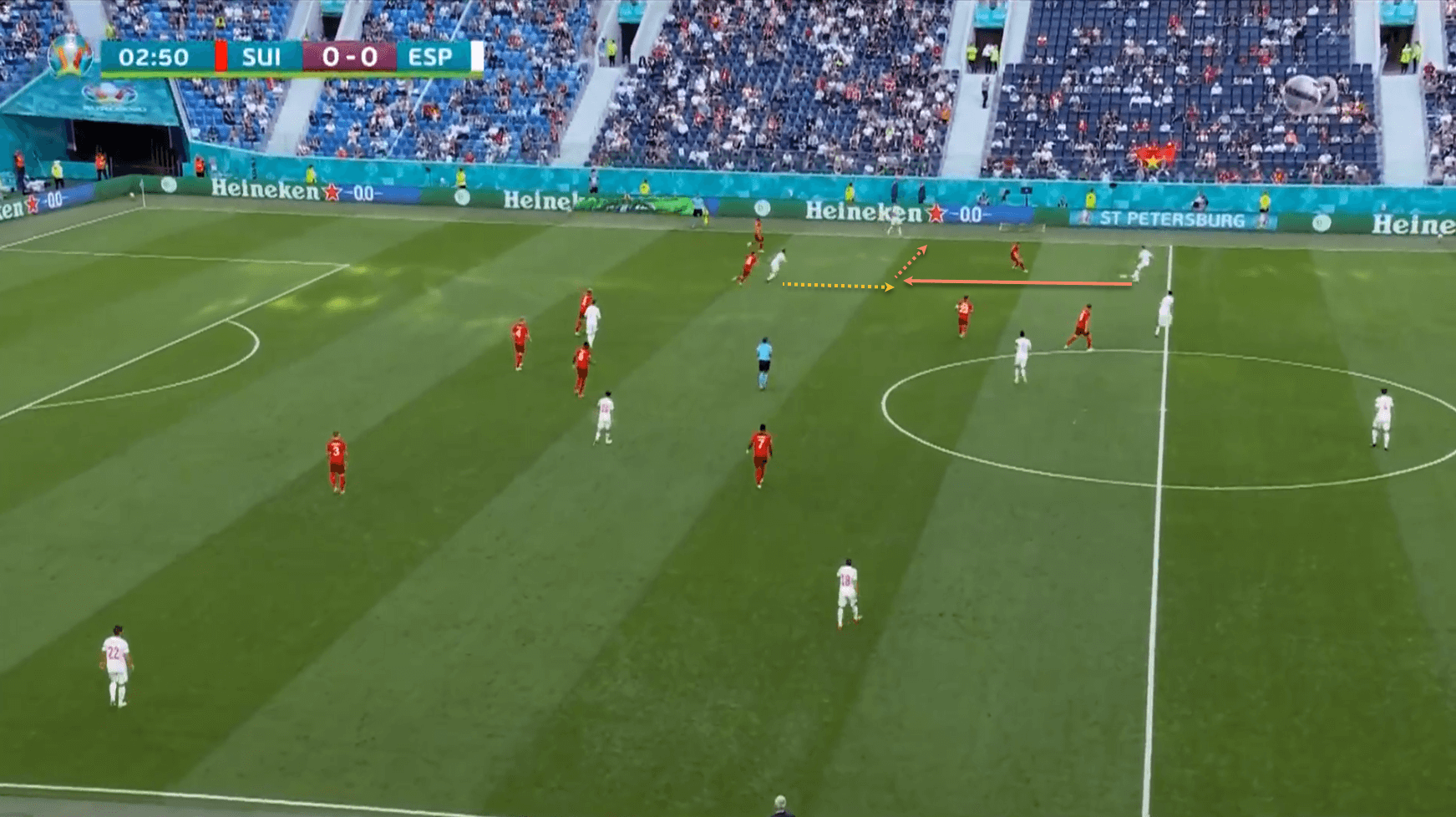
Azpilicueta, who is also relatively deep here, plays the ball to Koke, who is dropping to receive and moving his marker with him. The Atletico Madrid midfielder plays a one-touch pass to Ferran Torres on the touchline
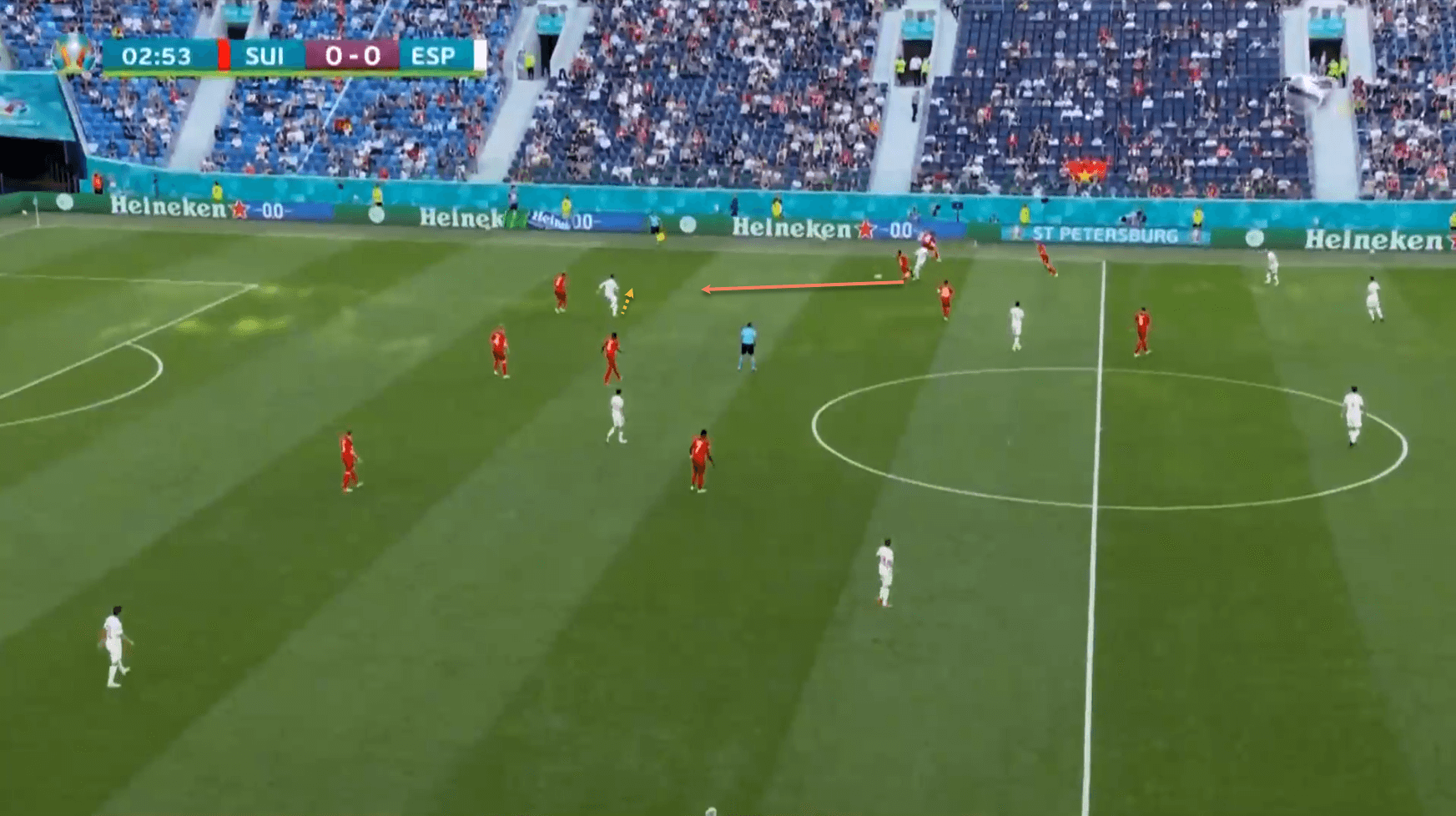
Torres draws the Swiss left-back out and plays the ball back to Koke, who then moves it on the Alvaro Morata – the Juventus striker dropping off from the defensive line to receive the ball
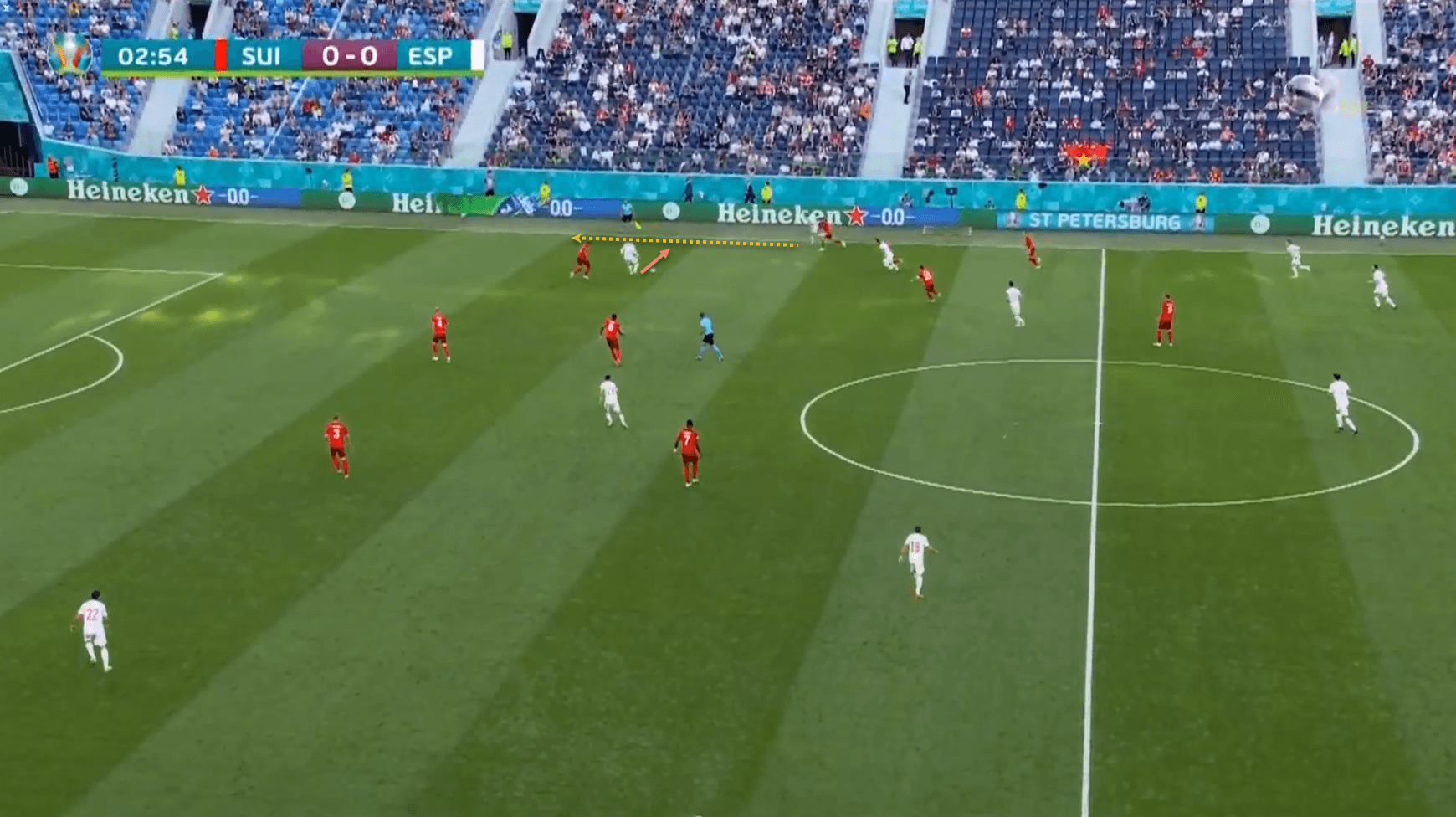
This movement draws Manuel Akanji, the centre-back marking Morata, out as well, and with the left-back high up the pitch too, Morata is able to lay the ball off for Torres to run onto and into space behind the Swiss backline.
Spain have also notable kept both wingers high and wide in the build-up to stretch the opposition and create space in the channels for Pedri and Koke to run into – this is another tactic that will be replicated against Italy as well.
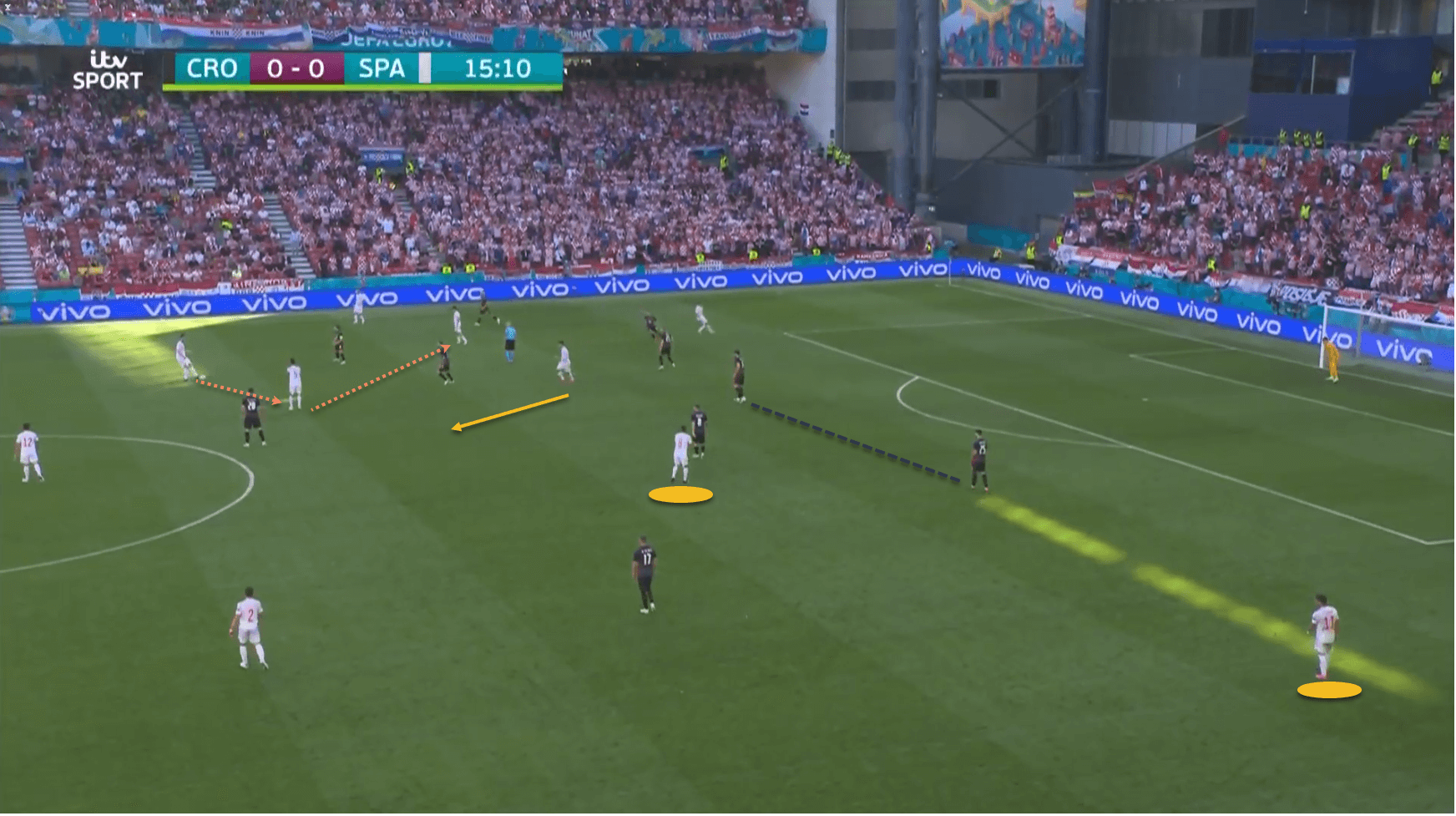
This is a good example of Spain’s use of width to stretch play, taken from that epic round of 16 game against Croatia. Note how Torres is extremely wide on the right – while he will not play a direct part in this move, his presence forces Joško Gvardiol to stay a little wider at left-back, which opens up the channel between him and Duje Ćaleta-Car. Álvaro Morata also drops off from the Croatian defensive line to try and drag a defender out. Laporte plays the ball to Busquets, who moves it on to Pedri…
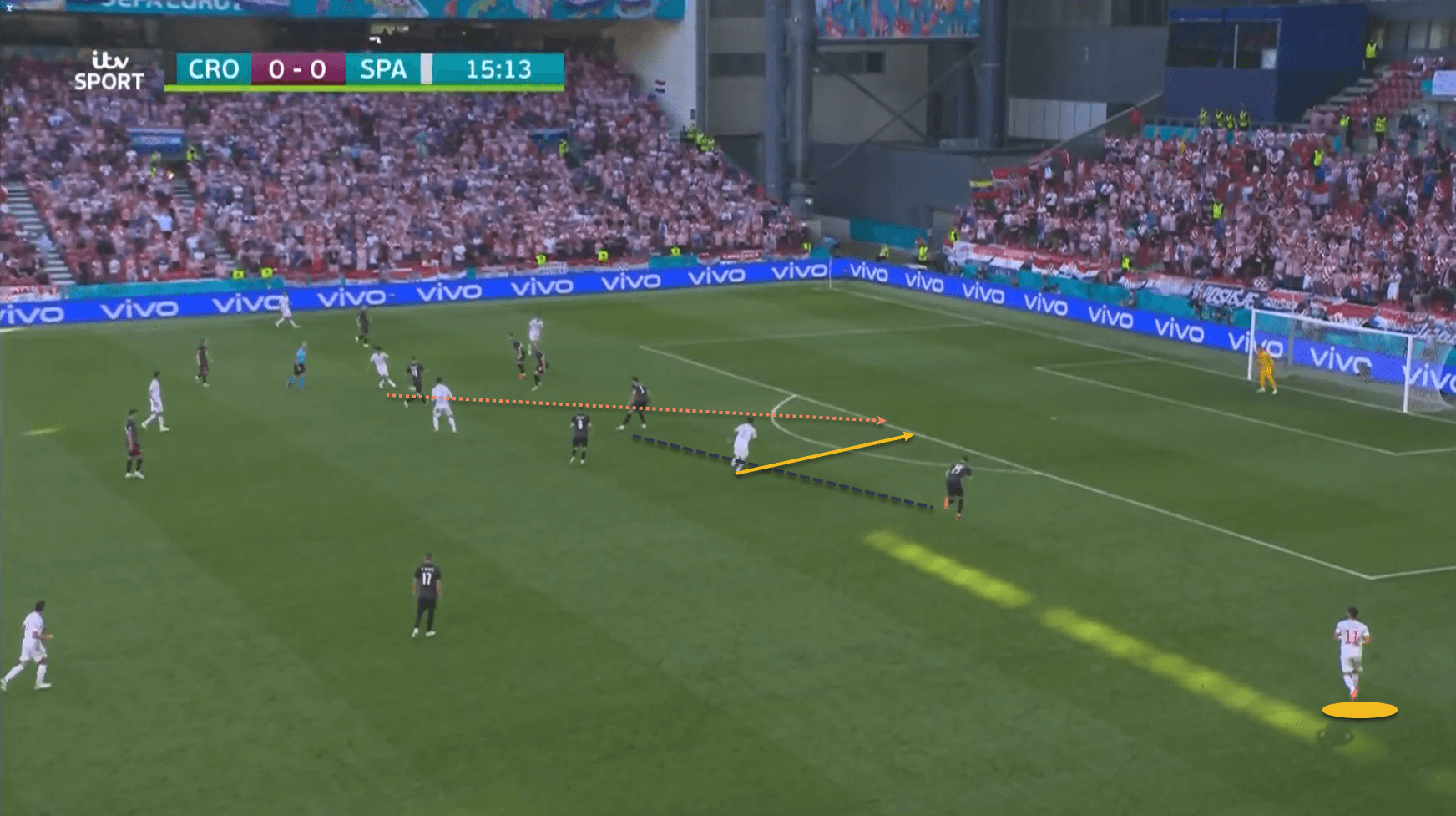
…and the Barcelona man can then find Koke, making a run from a deeper position in behind the Croatian defensive line.
Italy will therefore need to be defensively compact, especially in midfield, to avoid giving up these sort of spaces for Spain to attack.
Of course, Italy carry their own wide threat, even though Spinazzola’s absence will rob them of a lot of dynamism and attacking thrust. Giovanni Di Lorenzo, the right-back, usually tucks inside to form a back three alongside the two centre-backs, with the right winger, expected to be Federico Chiesa, pushing on to join the attacking line. Thus, Italy form a front five in possession, which can easily overwhelm the Spanish defence. However, as mentioned earlier, Emerson will not offer the same level of threat, which could also harm Insigne’s game as well.
Could Adama Traore be Spain’s secret weapon?
Pablo Sarabia’s absence will be a big blow for Spain – the Paris Saint-Germain attacker has played a huge role in La Roja’s attacking blueprint so far. Dani Olmo would be as close to a like-for-like replacement as possible, which is why we expect him to start instead. However, Luis Enrique does have a wildcard in the squad in the form of Wolves’ Adama Traore, and we have a feeling that he could very well be a secret weapon to be unleashed on Italy, especially with Spinazzola unavailable.
Traore’s key asset is his pace – it is near-impossible to catch up to him once he has gone past a player, and he could very well challenge Spinazzola’s claim as the fastest player at EURO 2020 so far if he gets any significant minutes on the pitch. With Emerson deputising at left-back for Italy, Spain could attempt to use Traore’s pace on the right to push Emerson back and reduce Italy’s attacking threat down their left flank. Additionally, if Emerson did push on, it would leave a lot of space for Traore to attack behind him, with the 36-year-old Georgio Chiellini forced to come over and cover – and that is a duel that the Italian, for all his experience and nous, will not relish. Jorginho, the player at the base of the Italian midfield, will also be no match in a foot race with Traore.
However, Traore is not as secure in possession as Olmo or Sarabia – Enrique wants his wingers to be able to progress the ball, yes, but they also need to be good technically to be able to pull of passing combinations in tight spaces. It is for this reason that Traore is unlikely to start – he could be an option off the bench, while Enrique could also turn to Marcos Llorente if he wants to have a similar level of directness with more safety in possession as well.
Who will start in midfield for Italy?
Marco Verratti’s return from injury in Italy’s last group stage game against Wales meant that Manuel Locatelli dropped to the bench, despite two superb performances in the previous two games. Italy have started with Verratti, Jorginho and Nicolo Barella in the two knockout games since then, and while there is no real reason for Mancini to change this setup, there may be a case to bring Locatelli back into the lineup instead of Verratti.
Verratti and Locatelli both play on the left of the midfield trio for Italy, and given the disruption caused due to Spinazzola’s injury, it may make sense to play the Sassuolo man, as he often moves wide and deep into a ‘false full-back’ (credit to Adam Scully for this term) position, helping to cover for the left-back’s forward bursts. Again, this will be useful to prevent Italy being caught out down that flank when attacks break down and Emerson is high up the pitch. Locatelli is also excellent on the ball, as he has shown already, and could offer more security in midfield as a result. Nevertheless, Verratti has already shown his quality at the tournament, and his ability to break lines with his passing and dribbling means that Mancini is likely to stick with the PSG midfielder for this match.
Conclusion
Italy and Spain have been two of the most impressive sides at EURO 2020 so far, and this is a semi-final that is being touted as the ‘final before the final’. Spain have had issues in terms of finishing off their attacks, and so Morata needs to be on top of his game here, up against two club colleagues in Chiellini and Leonardo Bonucci, while Italy will need to ensure that Spinazzola’s absence does not throw their team’s balance off-kilter. We expect this to be a tight, technical match, and it will be extremely interesting to see which team dominates possession, since both sides have the ability to keep the ball for long spells of the game.





Comments